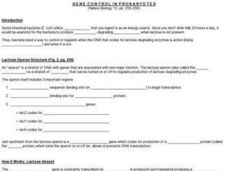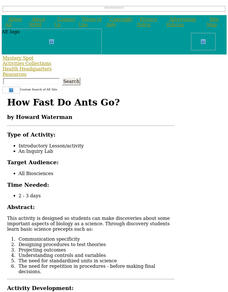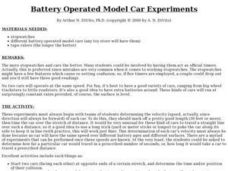Curated OER
Gene Control in Prokaryotes
In this gene control activity, learners use the example of the lactose operon structure to describe what happens when this structure is absent or mutated. This activity has 21 fill in the blank statements.
Curated OER
Visualizing a Human Gene with Its Introns & Exons
Students examine the entire DNA base sequence of the human adenosine deaminase gene after it is printed out from the source disk provided. The enormous length of a single gene as well as the immense difference in length between intron...
Curated OER
How Fast Do Ants Go?
Students make discoveries about some important aspects of biology as a science. They study basic science precepts such as communication specificity, designing procedures to test theories by designing an experiment that tests the speed of...
Curated OER
Virial Theorem Lesson
Ninth graders describe how equilibrium can occur as the balance of two effects. They model the stability of elliptical galaxies based on how fast stars within the galaxy are moving.
Curated OER
Cloud Sort
First graders gain a better understanding of types of clouds. They recreate clouds using Kidspiration. The types of clouds they study about are cirrus, cumulus, and stratus clouds.
Curated OER
Dancing Flamingos
Students, through the media of dance and drama, discover how an animal's behavior helps them to survive in the environment. They practice performing or mimicking how a flamingo's acts and positions itself when being observed. The...
Curated OER
Funny Putty
Students study that colloids are mixtures which display the properties of more than one of these states.
Curated OER
Physical Difference and Classification
Students use a microscope and observation skills to compare and contrast several physical properties and develop a classification system.
Curated OER
Rocket Racer
Students design their racer then trace their designs onto Styrofoam tray and athen attache a balloon to a strw which is attached to the "car" to construct a rocket propelled "car." They collect data to determine the speed and the...
Curated OER
Hurricanes and the Importance of Wetlands
Students explain how wetlands minimize the impact of hurricanes. In this earth science lesson plan, students investigate how different materials affect the steam plume path. They complete their worksheet after the lab.
Curated OER
Battery Operated Model Car Experiments
Students time battery operated cars over a set track and determine the velocity of each type of car. They use the cars as manipulatives to demonstrate word problems involving velocity.
Curated OER
Homer T. Cat, Poem
Students read a poem about a cat. Students discuss how cats behave and examine Homer's life in his environment.
Curated OER
Frogz
Students perform jumps and leaps from one lily pad to another to add to a study of frogs.
Curated OER
Wavelength and Energy
Students using a rope and other materials explore wavelengths and frequency. If time permits, more experiments can be tried.
Curated OER
JEPSON PRAIRIE RESERVE RESEARCH PROJECT
Learners research a field question of their choosing.
Curated OER
The Gulf of Maine
Pupils examine their own environments and make connections to larger ecosystems. They watch a video about the gulf of Maine and record the changes that have occurred. They research the gulf and create a food web.
Curated OER
Climate, Corals, and Change
Students examine oxygen isotope ratios and how they are related to water temperature. They also identify three forcing factor changes for climate change.
Curated OER
Graphing Inertia: An Oxymoron?
Eighth graders investigate Newton's Law of Inertia in order to create a context for the review of the use of different types of graphs. They practice gathering the data from an experiment and put it into the correct corresponding graph.
Curated OER
Soil, Forest, and Land Conservation
Students discuss the demands on the rainforest and devise a management plan that satisfies competing uses. They then construct a diorama to show the location of the various sites.
Curated OER
Island Research
Students collaborate to gather information about the geography, history, economy, climate, culture, and other aspects of life on the island of Eleuthera.
Curated OER
Sound
Second graders investigate the production of sound through experimentation. Working in pairs, 2nd graders receive supplies to create a sound machine. Once they create their machine and record the differences in the sounds produced.
Curated OER
Social Studies: Exploring Japan
Fourth graders examine the culture and environment of Japan, beginning with a KWL chart. They use clay and cups of water to construct representations of the Japanese Islands. After designing flags representing farming and food, 4th...
Curated OER
Patchwork of the Planet
Students are taught how satellite images can be joined to make a picture mosaic. They use actual satellite images to make satellite mosaics regions of the United States. Students use a camera to photograph portions of a globe in the...
Curated OER
Chromosomes and Genes in Action: Microviewer
In this chromosomes worksheet, students understand the make up of a DNA molecule and compare the different ways chromosomes are connected. This worksheet has 35 fill in the blank questions and 6 drawings.

























